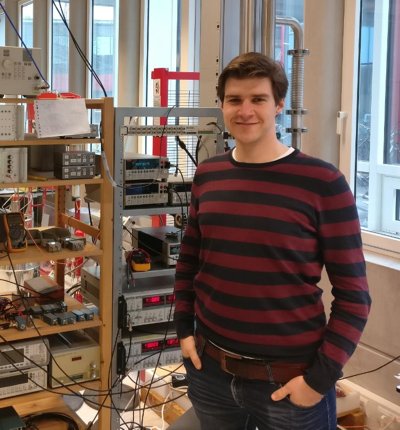manifold field effects at a complex oxide interface
Sander Smink is a PhD student in the Interfaces and Correlated Electron systems group (ICE). His supervisors are prof.dr.ir. J.W.M. Hilgenkamp and prof.dr.ir. W.G. van der Wiel from the Faculty of Science and Technology.
 The fundamental physical process underlying all consumer electronics on the market today is the (electric-)field effect. In the broadest sense of the word, it encompasses tuning the properties of a material by an electric field, which is usually done by externally applying a voltage. The elementary electronic building block, the field-effect transistor, nowadays comes by the billions on the size of a postage stamp, and is conventionally based on the material silicon. Replacing silicon by a different material may lead to electronic devices with novel functionality, such as devices that compute more efficiently or in a different way: for example, future devices may closely resemble the way nature 'computes' interactions between atoms and molecules; the realization of such devices is projected to enable breakthroughs in medical and material sciences. In this light, the conducting interface between lanthanum aluminate (LaAlO3) and strontium titanate (SrTiO3) is especially appealing: it exhibits exotic phenomena like superconductivity and magnetism, which are highly tunable by an externally applied voltage. These unique characteristics make this interface a promising platform for better understanding these phenomena on a fundamental level, as well as for creating new electronic devices for innovative computing methods.
The fundamental physical process underlying all consumer electronics on the market today is the (electric-)field effect. In the broadest sense of the word, it encompasses tuning the properties of a material by an electric field, which is usually done by externally applying a voltage. The elementary electronic building block, the field-effect transistor, nowadays comes by the billions on the size of a postage stamp, and is conventionally based on the material silicon. Replacing silicon by a different material may lead to electronic devices with novel functionality, such as devices that compute more efficiently or in a different way: for example, future devices may closely resemble the way nature 'computes' interactions between atoms and molecules; the realization of such devices is projected to enable breakthroughs in medical and material sciences. In this light, the conducting interface between lanthanum aluminate (LaAlO3) and strontium titanate (SrTiO3) is especially appealing: it exhibits exotic phenomena like superconductivity and magnetism, which are highly tunable by an externally applied voltage. These unique characteristics make this interface a promising platform for better understanding these phenomena on a fundamental level, as well as for creating new electronic devices for innovative computing methods.
The main result of this thesis is that the field effect at the LaAlO3 - SrTiO3 interface goes beyond accumulating and depleting charges in a channel. Correlated-electron phenomena such as superconductivity and magnetism are deeply connected to the electronic band structure; the magnetotransport studies described in this thesis show that an externally applied gate voltage can change the band structure of this interface; a direct manifestation of the Schrödinger equation, this premier result establishes electrostatic control over the fundamental electronic properties of a material. The following chapters show that this evolution of the band structure with gate voltage is closely related to tuning superconductivity in this system, and that the electrostatic confinement is the main factor distinguishing bulk and surface states. Finally, the limits of complex-oxide field-effect devices are explored in terms of electric field strength, dielectric layer thickness, and lateral dimensions. In general, this thesis contributes both to the fundamental understanding of the field effect in advanced materials, and to the boundary conditions of using such materials in functional devices.


